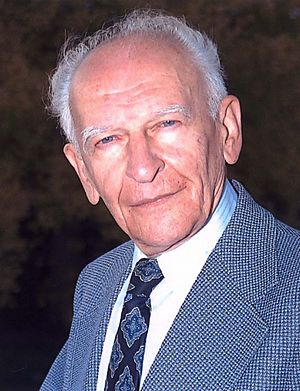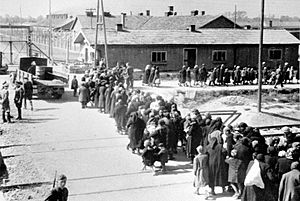Tibor Baranski facts for kids
Quick facts for kids
Tibor Baranski
|
|
|---|---|

Tibor Baranski
|
|
| Born |
Tibor Baránszki
June 11, 1922 Budapest, Hungary
|
| Died | January 20, 2019 (aged 96) Buffalo, New York, U.S.
|
| Nationality | Hungarian-American |
| Other names | Baranski |
| Occupation | Teacher |
| Known for | Saved more than 3,000 Jews during World War II |
| Spouse(s) |
Katalin Kőrösy
(m. 1957–2011) |
| Children | Peter Forgach, Tibor Jr., Katalin |
| Parent(s) | Reszl Baránszki and Maria Schelnader |
| Awards | Righteous Among the Nations |
Tibor Baranski (Hungarian: Baránszki Tibor; June 11, 1922 – January 20, 2019) was a brave Hungarian-American man. He is known for saving over 3,000 Hungarian Jewish people during the Holocaust in World War II.
When he was 22, Tibor had to leave his studies and return to Budapest. He boldly went to the home of Papal Nuncio Monsignor Angelo Rotta, who was the Vatican's representative. Tibor convinced Rotta to give him special papers. These papers helped a Jewish family, who were friends of his aunt, escape from Hungary.
Rotta was so impressed by Tibor's courage that he asked him to help save more Jewish people. Over just nine weeks, before Soviet soldiers surrounded Budapest, Tibor helped rescue more than 3,000 Jews.
Tibor was arrested by the Soviets in December 1944. He was forced to march 160 miles to a Soviet prison. He barely ate during this difficult journey. A kind guard helped him, and he eventually returned to Budapest. Later, in 1948, he was arrested again and sent to prison for nine years. He was released in 1953 after Joseph Stalin died.
In 1956, Tibor left Hungary during a revolution. He and his wife settled in New York, where they became U.S. citizens and teachers. In 1979, Tibor Baranski was recognized as one of the Righteous Among the Nations by Yad Vashem, an important honor for people who saved Jews during the Holocaust.
Contents
Tibor's Early Life
Tibor Baránszki was born in Budapest, Hungary. His parents were Reszl Baránszki and Maria Schelnader. His family had lived in Hungary for a very long time.
He went to school in Hungary. By 1938, he started to notice the rise of antisemitism, which is hatred towards Jewish people. In 1940, he began studying to become a priest. He learned about the Nazi government's plans to kill Jewish people through his church. As the Soviet army got closer, Tibor had to leave his studies and return to Budapest on October 20, 1944.
Saving Lives During World War II
Tibor's aunt, Margit Sterneder, was very close friends with a Jewish family, the Szekeres family. They became even closer as the situation for Jewish people in Hungary became very dangerous.
Hungary's Anti-Jewish Laws
Starting in 1938, the Hungarian government, led by Miklós Horthy, began passing laws against Jewish people. These laws were similar to Germany's Nuremberg Laws. They limited how many Jewish people could work in certain jobs. Later laws defined who was Jewish based on their family history, not just their faith. Many Jewish people lost their jobs and their right to vote.
Germans Take Over Hungary
In early 1944, Hungary's prime minister was trying to make peace with the Allies in secret. To stop this, Germany sent troops into Hungary on March 19, 1944. A far-right group called the Arrow Cross Party took power.
Jews Sent to Death Camps
Soon after, large groups of Jewish people were sent to German death camps in occupied Poland. A Nazi officer named Adolf Eichmann came to Hungary to manage these deportations. Between May and July 1944, over 437,000 Hungarian Jews were sent away. Most of them went to Auschwitz-Birkenau, where 90% were killed upon arrival. About one in three of all Jews killed at Auschwitz were Hungarian.
By June, Jewish people in Hungary were forced to move into special "Yellow Star Houses." These were mini-ghettos marked with a yellow Star of David. The Szekeres family went into hiding, leaving their baby son, Gabor, with Tibor's aunt.
Fascists Take Control
In October 1944, the Hungarian leader Horthy tried to make a secret peace with the Soviets. In response, the Nazis kidnapped Horthy's son. They forced Horthy to step down, and Ferenc Szálasi, the leader of the Arrow Cross Party, took over.
Under Szálasi, Arrow Cross members often raided Jewish areas. They took groups of Jews to the Danube River and killed them.
Tibor Seeks Church Help
When Tibor returned to Budapest in October 1944, the city was controlled by German forces. His aunt asked him to contact Catholic church officials for help for the Szekeres family.
Tibor went to the embassy residence of Papal Nuncio Monsignor Angelo Rotta. Many people were waiting in long lines for protection papers. Tibor, dressed in his priest's cassock, bravely pushed his way to the front. He told people he was on official business. He knew that if one person in a family was Catholic, the whole family might get protection.
Tibor found Rotta's office and convinced him to give him nine protection letters for the Szekeres family. Encouraged by this success, Tibor returned a few days later for another family.
Rotta was impressed by Tibor's courage and his excellent German. He asked Tibor to help protect more Jews. Rotta gave Tibor protection letters, baptism certificates, and immigration papers. Over the next 70 days, Tibor used these to save thousands of Jews.
Two weeks later, Rotta made Tibor the leader of the Vatican's Jewish Protection Movement in Hungary. Tibor worked with other diplomats from neutral countries, like Raoul Wallenberg from Sweden. Wallenberg is famous for saving tens of thousands of Hungarian Jews. Tibor also met with Carl Lutz from Switzerland and Ángel Sanz Briz from Spain.
Tibor personally took people to hiding places. These included secret rooms in factories and homes of other Catholics. He said he and Wallenberg shared the same "recklessness" and "determination" to save lives.
Tricking the Guards
Rotta asked Tibor to go to a factory where 50 baptized Jews were held before being sent to death camps. Tibor insisted on borrowing Rotta's large diplomatic Rolls-Royce limousine, flying the Vatican flag. He believed the Nazis would be more impressed by a fancy car than a small one.
Tibor, dressed as a priest, acted very important. At the factory, the guards didn't want to open the gates. Tibor threatened to crash the car through them! They finally opened the gate. Tibor found 2,000 Jews inside. He called out the names of the baptized individuals he was there to save. While he distracted the guards, his helpers gave the other Jews information on how to contact the underground resistance.
Tibor also bravely stopped groups of Jews who were being marched to death camps. Using fake Vatican papers, he convinced guards to let him take some prisoners back to Budapest.
In November 1944, about 50,000 Jews were forced to march from Budapest to the Austrian border. Many died from hunger, cold, and sickness. Rotta sent Tibor to help them. Tibor brought hundreds of Jews back to Budapest by train. He also paid for food and supplies for thousands of Jews hiding in Vatican-protected houses. He worked day and night, often without sleep or food.
Tibor knew he would be killed if his tricks were discovered. He said his strong Catholic faith gave him the courage to keep going. When a German officer pointed a gun at his head and asked why he helped Jews, Tibor replied, "It is because I am a Christian that I help the Jews."
Once, Adolf Eichmann himself called Tibor. Eichmann said that only 3,000 of the 12,000 protection letters would be honored. Tibor, not knowing who he was talking to, told Eichmann, "I thought I was talking to a German officer, not a German scoundrel." Tibor then helped those whose letters were no longer valid to hide in old houses and wine cellars. He believed he saved between 8,000 and 12,000 Jews this way.
Tibor was arrested by the Soviets on December 30, 1944.
Arrest and Imprisonment
The Soviets began to surround Budapest in late December. They arrested Tibor because they thought he supported the Nazis. He was forced to march 160 miles to a prison in Russia. He ate only four times in 16 days. He believed a kind Soviet guard saved his life by preventing another guard from shooting him.
Tibor was hospitalized and eventually returned to Budapest after the war. He finished his studies and became a vicar. But he didn't like the Communists any more than the Nazis. In 1948, he was arrested again for being against the Communists. In a show trial (a trial where the outcome is already decided), he was sentenced to nine years in prison. He was released in 1953 after Joseph Stalin died.
Tibor said his only reward for the risks he took would come from God. "I only did what God demanded of me. I'm only a useless servant," he said.
Life After the War
After being freed from prison in 1953, Tibor became a freedom fighter during the Hungarian Revolution of 1956. He helped organize support for the revolution. When the Soviets crushed the rebellion, Tibor didn't want to go back to Hungary. He said, "If you want to think like a cartoonist, Hitler and Stalin would be two cherries on the same tree. There was no difference." He managed to escape Hungary with other refugees.
He stayed in Italy and married Katalin Kőrösy on July 8, 1957. They lived in a refugee camp near Rome for about a year and started a school for refugees. In 1958, they moved to Canada, then to Buffalo, New York in 1961, where they raised their family.
Katalin became a professor of biochemistry and cancer researcher at the University of Buffalo. She passed away in 2011. Tibor adopted Katalin's son, Peter Forgach, who became an eye surgeon. Their son, Tibor Baranski Jr., became an international lawyer. Their daughter, Kati, works in communications for the Diocese of Buffalo.
Honoring a Hero
Tibor Baranski was one of the last people alive who witnessed the efforts to protect Jews in Budapest during the war. On January 11, 1979, he was named a Righteous Among the Nations by Yad Vashem. His aunt, Margit Sterneder, also received this honor. Monsignor Angelo Rotta, who helped Tibor, was recognized in 1997.
Gabor Szekeres, the first person Tibor saved, survived the war. Gabor's wife, Agnes, whose parents were killed in the Holocaust, said of Tibor, "He fought, and he was willing to sacrifice his life, for what he thought was right." The two families are still close today.
In 1980, President Jimmy Carter appointed Tibor to the U.S. Holocaust Memorial Council. He helped guide the creation of the Holocaust memorial. In 2013, Tibor received the Hungarian Honorary Cross of the Order of Merit.
Tibor's son, Tibor Baránszki Jr., helped connect his father with the family of Raoul Wallenberg. In 2017, Tibor Sr. was invited to be a special guest at the Raoul Wallenberg Day events in Stockholm. The Israeli Postal Authority also issued a stamp to honor Tibor Baránszki in April 2017.
Tibor's adopted son, Peter Forgach, said people used to ask Tibor how he could still believe in God after all he had seen. Tibor would reply, "These things happened, and there has to be a God to bring justice."



